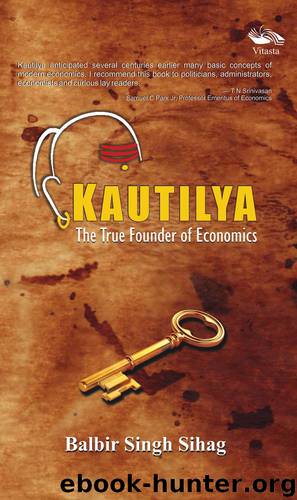Kautilya- the True Founder of Economics by Balbir Singh Sihag

Author:Balbir Singh Sihag [Sihag, Balbir Singh]
Language: eng
Format: epub
ISBN: 9788192535494
Publisher: Vitasta Publishing Pvt Ltd
Published: 2014-04-08T00:00:00+00:00
13.1 KAUTILYA’S CONCEPTUAL FRAMEWORK FOR PREVENTION OF FAMINES Ranking of Natural Disasters according to their Impact: Kautilya ranked the seriousness of the various natural disasters. He first compared the relative seriousness of a drought to that of too much rain and concluded that drought was more serious. He (p 129) asserted, ‘a drought is worse than too much rain, because drought destroys livelihood (8.2)’. Then he compared the seriousness of floods to that of fire. He (p 131-132) added, ‘[Which of the divine calamities are more serious than others?] Some teachers say that fire is more serious than floods because destruction by fire is irremediable, consuming all; one can escape from floods and its damage can be alleviated. Kautilya, however, considers floods to be more dangerous because it destroys hundreds of villages while fire destroys [only] one village, or a part of it.’ He concluded floods to be more serious.
Then he proceeded to compare the seriousness of a famine to that of disease and epidemics. He argued, ‘Some teachers say that disease and epidemics are worse than famine, because pestilence brings all state activities to a stop with men falling ill and dying but during famine all work does not stop and it is still possible to collect revenue in gold or commodities or cattle. Kautilya disagrees. Pestilence usually devastates only a region of the country and remedies can be found for the disease. Famine, on the other hand, affects the whole country and deprives the people of their livelihood (8.4).’1 Kautilya argued that threat of a drought created a systemic risk since it affected the whole economy, whereas, fires, epidemics and floods did not create any systemic risk.
Foresightedness as a Critical Requirement for Risk Management: According to Kautilya, the king as well as his advisers should have the ‘ability to foresee things’. He described some desirable attributes of a king. He (p 119-120) wrote, ‘He should be just in rewarding and punishing. He should have the foresight to avail himself of the opportunities (by choosing) the right time, place and type of action (6.1).’ Similarly, he (p 120) described, ‘A councilor or minister of the highest rank should be a native of the state, born in a high family and controllable [by the king]. He should have been trained in all the arts and have logical ability to foresee things (1.9).’
He provided a very broad definition of a calamity. He (p 122) wrote, ‘That which deprives (vyasyati) a person of his strength and goodness is a vyasana (a vice, adversity or calamity) (8.1.4).’ According to him, a king should take preventive and remedial measures to reduce the impact of a calamity. He (p 116) stated, ‘In the interests of the prosperity of the country, a king should be diligent in foreseeing the possibility of calamities, try to avert them before they arise, overcome those which happen, remove all obstructions to economic activity and prevent loss of revenue to the state (8.4).’
Preventive Measures: He emphasized investment on expansion of irrigation facilities and infrastructure.
Download
This site does not store any files on its server. We only index and link to content provided by other sites. Please contact the content providers to delete copyright contents if any and email us, we'll remove relevant links or contents immediately.
International Integration of the Brazilian Economy by Elias C. Grivoyannis(90978)
The Radium Girls by Kate Moore(11921)
Turbulence by E. J. Noyes(7936)
Nudge - Improving Decisions about Health, Wealth, and Happiness by Thaler Sunstein(7615)
The Black Swan by Nassim Nicholas Taleb(7010)
Rich Dad Poor Dad by Robert T. Kiyosaki(6401)
Pioneering Portfolio Management by David F. Swensen(6226)
Man-made Catastrophes and Risk Information Concealment by Dmitry Chernov & Didier Sornette(5921)
Zero to One by Peter Thiel(5685)
Secrecy World by Jake Bernstein(4644)
Millionaire: The Philanderer, Gambler, and Duelist Who Invented Modern Finance by Janet Gleeson(4374)
The Age of Surveillance Capitalism by Shoshana Zuboff(4209)
Skin in the Game by Nassim Nicholas Taleb(4162)
Bullshit Jobs by David Graeber(4094)
The Money Culture by Michael Lewis(4076)
Skin in the Game: Hidden Asymmetries in Daily Life by Nassim Nicholas Taleb(3929)
The Dhandho Investor by Mohnish Pabrai(3699)
The Wisdom of Finance by Mihir Desai(3653)
Blockchain Basics by Daniel Drescher(3507)
